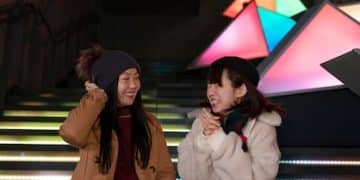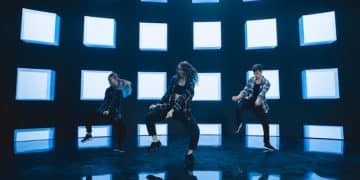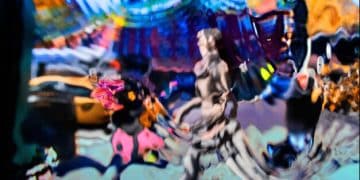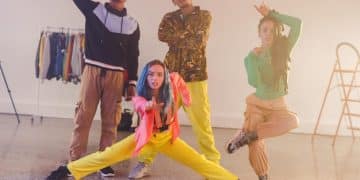The Art of K-Pop MVs: Decoding Visuals & Symbolism

The Art of K-Pop Music Videos: Analyzing Visual Storytelling and Symbolism reveals how these videos transcend mere promotion, employing sophisticated techniques to craft immersive narratives and enhance the music’s emotional impact, blending artistic vision with cultural nuance.
K-Pop music videos are more than just eye candy; they’re meticulously crafted works of art that blend music, visuals, and storytelling. An exploration into the art of K-Pop music videos: analyzing visual storytelling and symbolism reveals that these videos contain layers of artistic expression.
Decoding K-Pop Aesthetics: An Introduction
K-Pop music videos are renowned for their elaborate sets, cutting-edge fashion, and complex choreography. The visual elements are not merely decorative; they play a crucial role in conveying the song’s message and creating a lasting impression on viewers. Understanding these elements can greatly enhance one’s appreciation of the genre.
The production quality of K-Pop music videos sets them apart from the music videos of many other genres. High production values, combined with artistic direction, contribute to the overall immersive experience for the audience.
Evolution of Visual Styles in K-Pop
K-Pop visuals have evolved dramatically since the genre’s inception. Early K-Pop videos often featured simpler sets and storylines. Today’s videos incorporate advanced techniques like CGI and elaborate set designs.
- Early K-Pop videos were often simpler, focusing on performance.
- The “Hallyu Wave” boosted investment in higher production values.
- Current trends feature complex narratives and symbolism.
The industry is continuing to innovate through the adoption of new technologies. The use of augmented reality and virtual reality elements are enhancing digital interaction.
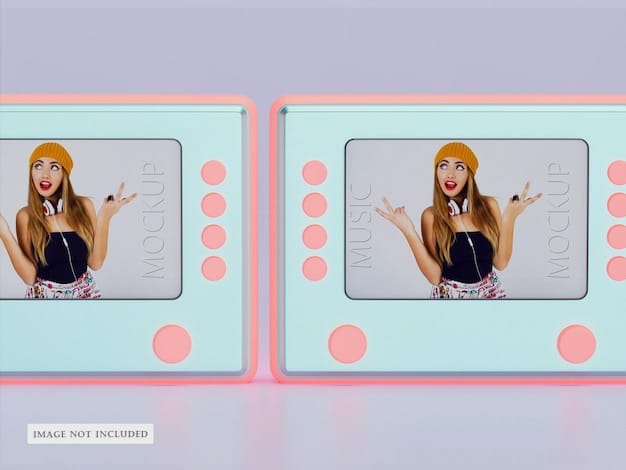
This continuous evolution keeps the visuals fresh and exciting, while pushing the boundaries of what is possible in music video production.
Narrative Structures: Stories Told in Song
Many K-Pop music videos go beyond simple performances to tell stories. These narratives can range from romantic dramas to complex plots involving fantasy and adventure. Examining these structures helps viewers understand the artistic intentions behind the visuals.
These narratives add depth to the music, transforming a simple song into an immersive and cinematic experience. Exploring K-Pop leads to an understanding of how these videos use the music to create stories.
Music videos can have narratives that range from those based on simple feelings to ones with multiple interpretations.
- Some narratives are direct interpretations of the song lyrics.
- Others use allegory and symbolism to convey deeper themes.
- Many videos combine performance with narrative elements.
Understanding basic narrative structures can provide clues to understanding the art. This helps the viewer get the most out of the symbolism used within the video.
Symbolism in K-Pop: Deciphering the Codes
Symbolism is a crucial component of K-Pop music videos. Artists often use symbols to add layers of meaning to their work, inviting viewers to engage with the content on a deeper level. Understanding common symbols can enrich the viewing experience.
Various symbols like colors, objects, and settings represent different ideas and emotions. Learning to recognize these can greatly enhance your understanding of that media.
Common Symbols and Their Meanings
Some common symbols in K-Pop videos include flowers (representing beauty or fragility), birds (freedom or escape), and water (purity or transformation). The specific context in which these symbols appear often determines their precise meaning.
Symbolism in these videos comes from a variety of backgrounds. These can be based on culture or even direct references to literature and mythology.
Choreography as a Visual Language
Choreography is more than just dance moves in K-Pop; it’s a visual language that conveys emotions and tells stories. Precise, synchronized movements can express themes of unity, while dynamic and energetic steps can convey the energy of youth.
Choreography is essential for conveying the message in many K-Pop videos. The high energy and complex dance moves create a visual message that reinforces the song.
The types of dances used within the videos can have a wide background depending on the song.
- Synchronized group dances emphasize teamwork and community.
- Solo performances can showcase individual talent.
- Dance styles often reflect the song’s genre and theme.
Consider the various themes and styles used within each video to understand the visual language. Seeing the dancing as a set of symbols can enhance your enjoyment of the video.
Fashion and Style: Visual Identity
Fashion is integral to the visual identity of K-Pop artists. Costumes are carefully chosen to reflect the concept of the song and the personality of the performers. Analyzing these choices can reveal insights into the artist’s vision.
The clothing worn in a K-Pop music video can range widely depending on the video, and reflects the personalities of the artists.
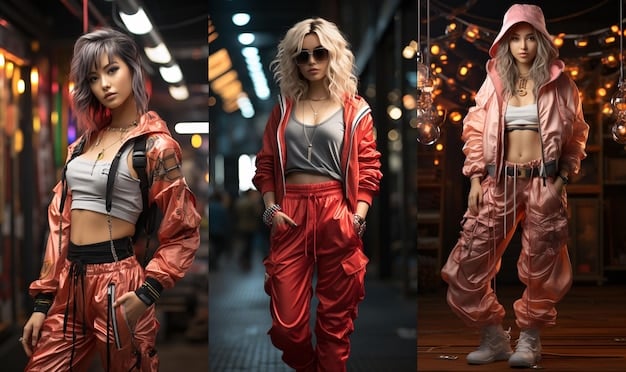
The Role of Stylists
Stylists play a crucial role in crafting the visual identity of K-Pop groups. They collaborate with artists and directors to create cohesive and impactful looks that enhance the overall aesthetic of the music video.
The styles used can reinforce various ideas or feelings throughout the video.
Color Psychology: Setting the Mood
Color is a powerful tool in K-Pop music videos, used to evoke specific moods and emotions. Bright, vibrant colors can create a sense of energy and excitement, while darker, muted tones can convey feelings of melancholy or introspection.
Color plays a huge role and can have various meanings in each video. Specific groups or videos may use a standard set of colors, leading to greater association.
Color can be used in many ways throughout the video. It can be displayed by clothing or even physical effects.
- Red often signifies passion, energy, or danger.
- Blue can represent calmness, sadness, or spirituality.
- Yellow typically conveys happiness and optimism.
The conscious use of color can greatly increase the impact of a K-Pop video.
Understanding the uses of color within the video is essential to making a complete read on its meaning.
Technological Innovations: The Future of K-Pop Visuals
K-Pop music videos are at the forefront of technological innovation in visual media. The use of CGI, virtual sets, and interactive elements has transformed the genre into a multimedia experience. These advances continue to push the boundaries of creativity.
Innovations in digital and physical media both have an impact on K-Pop today. Production quality is also continuing to develop as both technology and capital investment increases.
- CGI allows for creating fantastical worlds and effects.
- Virtual sets provide endless possibilities for set design.
- Interactive elements engage viewers more directly.
These technological advancements contribute to the immersive and visually stunning nature of K-Pop music videos. The possibilities continue to rise as tech continues to be developed.
| Key Aspect | Brief Description |
|---|---|
| 🎬 Visual Storytelling | Narrative structures create immersive, cinematic experiences. |
| ✨ Symbolism | Symbols in K-Pop videos include colors, objects, and settings. |
| 💃 Choreography | Synchronized dances emphasize unity. |
| 🌈 Color Psychology | Color used to evoke specific moods and emotions. |
FAQ
▼
K-Pop music videos stand out due to their high production values, elaborate sets, and integration of complex narratives. They often incorporate advanced CGI and interactive elements, creating an immersive, memorable experience for viewers.
▼
Choreography is highly important, serving as a visual language that conveys emotions and stories. Synchronized movements often express unity, while dynamic steps reflect energy and youthfulness, enhancing the video’s thematic message.
▼
Fashion is integral to the visual identity of K-Pop artists, reflecting the concept of the song and the personality of the performer. Stylists carefully choose costumes to create cohesive, impactful looks that elevate the video’s overall aesthetic.
▼
Color is a powerful tool in K-Pop videos, used to evoke specific moods and emotions. Bright colors create energy, while muted tones convey melancholy, setting the mood to enhance engagement.
▼
K-Pop music videos often feature CGI, virtual sets, and interactive elements, pushing the boundaries of creativity and creating an innovative experience for viewers. These elements transform the genre into a multimedia journey.
Conclusion
K-Pop music videos are rich in artistry, storytelling, and symbolism, making them much more than promotional tools. By understanding the nuances of visual language, color psychology, and technological innovations, viewers can gain a deeper appreciation for the dedication and creativity that goes into these productions.
